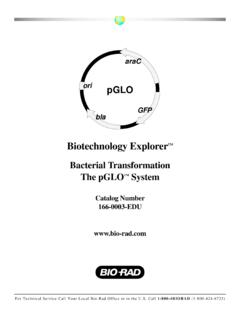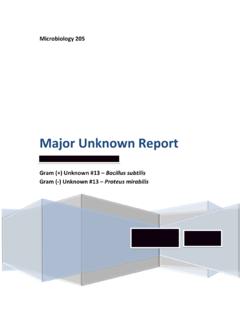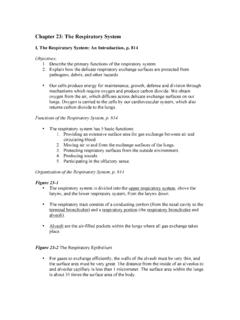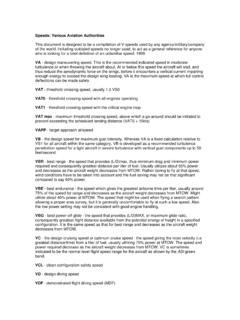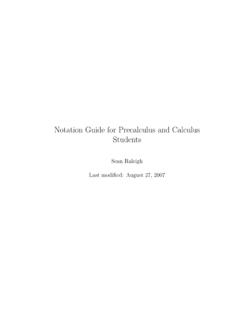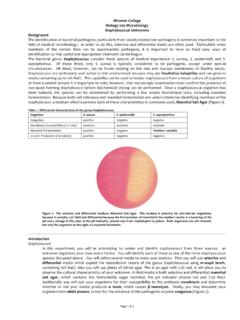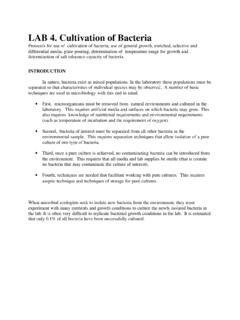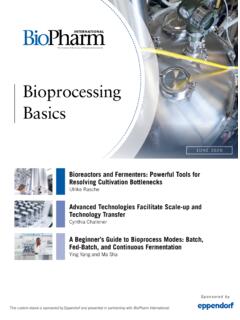Transcription of Lab Exercise 3: Media, incubation, and aseptic technique
1 Lab Exercise 3: Media, incubation, and aseptic technique Obj ectiv es 1. Compare the different types of media. 2. Describe the different formats of media, plate, tube etc. 3. Explain how to sterilize it, and how to distribute it in different formats. 4. Produce Nutrient agar (NA) plates, NA slants, and Nutrient broths (NB)which will be used in subsequent lab periods. 5. Know the laboratory equipment and culture media needed to develop and maintain pure cultures 6. Carry out aseptic technique for the removal and transfer of microorganisms for culturing. 7. Correctly sterilize and flame transfer instruments and tubes. 8. Properly incubate culture media at the appropriate temperature for the organism and the length of incubation. Introductio n I. Media Media Containers: Media can come in liquid forms called broths. If a solidifying agent like agar is added the broth, is now a solid media.
2 Solid media is prepared into Petri plates or in tubes as slants or deeps. If a larger tube is filled with a solid media it is called a Pour and is used to pour the media into a plate at a later time. Slants Deeps Petri plate Microbiology Media Preparation: Bacteria and fungi are grown on or in microbiological media of different types. The medium that is used to culture the microorganism depends on the microorganism that one is trying grow. Added certain substances to the medium can make it useful for selecting different types of organisms and differentiating between types as well. Sometimes a pH indicator may be added for differentiation of microbes based on their biochemical reactions: the indicators may turn one color when slightly acidic, another color when slightly basic. In this lab, your group will make media called nutrient broth and nutrient agar.
3 These 2 media----one a liquid and the other a solid---are the exact same formula save for the addition of agar agar (really---agar agar), an extract from the cell walls of red algae. This particular medium will grow MOS T bacteria that we use in lab. There are two general types of media. One is made with a chemical recipe. This medium is called a chemically defined media. Some of our media is made from extracts and digests of yeast, meats or other food sources. Since this type of medium has some unknown ingredients it is called complex media. It is really not very complex to make complex media: 1. rehydrate the powder form of the medium 2. stir and just bring to a boil the medium to get it all well dissolved 3. distribute the media into tubes or leave in flask for plates 4. autoclave to sterilize the tube media 5. autoclave the agar medium for plate production and then pour into sterile petri dishes and cool S TERILIZATION AND THE AUTOCLAVE When microbiological media has been made, it still has to be sterilized because of microbial contamination from air, glassware, hands, etc.
4 There will be thousands of bacteria reproducing in the media so it has to be sterilized quickly before the microbes start using the nutrients up. The sterilization process is a 100% kill, and guarantees that the medium will stay sterile UNLESS exposed to contaminants by less that adequate aseptic technique to exposure to air. Media sterilization is carried out with the autoclave, basically a huge steam cooker. Steam enters into a jacket surrounding the chamber. When the pressure from the steam is at a certain point in the jacket, a valve allows the steam to enter the chamber. The pressure will go up over 15 pounds per square inch (psi): at this point the timer begins to count down---usually for 15 minutes, depending on the type of media. The high pressure in a closed container allows the temperature to go above the highest temperature one could get by just boiling, around 121 C.
5 Therefore, we general set the autoclave to sterilize at 121 C at, 15 psi for 15 minutes. Fifteen minutes is for most organisms (except some really hardy spore formers). The prepared media is distributed in different containers, depending on the form one is making. Broths, agar slants and deeps are put into tubes and then sterilized. A rack with agar slant tubes are laid on a slant, tilted after sterilizing to allow the agar to solidify in a slanted fashion. Agar medium to will be poured into plates is sterilized in a flask, and then poured afterward autoclaving. Not all media or solutions can be sterilized via an autoclave. II. Incubatio n cultivation chambers called incubators are used to grow microbes at a range of temperatures. In this lab, we have set incubators for two temperatures most commonly used as optimum temperatures by the microbes we work with: 25 C and 37 C.
6 We also have an incubator set at 4 C (aka a refrigerator!) that can be used to store cultures that have already grown. Unless otherwise noted in a laboratory Exercise , you should use the following guidelines for incubation: 2 day incubations- 37 C 5 day incubations- 25 C III. As eptic tech n iqu es aseptic technique refers to protocols and procedures you use to insure that no microbes contaminate your experiment and that the microbes you are working with do not contaminate you, your colleagues, or working environment, or your loved ones at home! Because microorganisms are ubiquitous, you need to assume that every environment is replete with them. This laboratory Exercise will introduce you to the procedures required to ensure a safe and aseptic laboratory. Before beginning today s laboratory Exercise , become acquainted with the terminology and techniques: Work area disinfection Before beginning any laboratory experiment, you must spray down the lab bench with a surface disinfectant, such as Cavicide.
7 Saturate the bench with the solution and rub in to cover the area. Do NOT use paper towels to completely dry the surface, but instead let the disinfectant evaporate. A large portion of the disinfectant s ability to kill microbes is based on contact with the microbe itself. You must repeat this procedure at the end of every laboratory session. Transfer instruments- loops and needles Wire loops and needles are made from inert metals such as platinum. They are extremely durable and can be sterilized by incineration. To do this, place the loop or needle into the flame of a Bunsen burner (the hottest portion is in the blue flame). Allow the loop or needle to get red hot, and then remove. Make sure the transfer instrument is cool before inserting into a culture for inoculation. You will do this prior to any inoculation and after any inoculation.
8 Culture tube flaming Prior to inserting a cooled transfer instrument into a culture tube, you need to remove the cap and flame the lip of the tube. This will help prevent contamination with transient and airborne microbes. You will do this before and after any contact with a transfer instrument. Culture tube inoculation To inoculate a culture tube, you must determine the type of culture tube being used and follow the appropriate protocol: Broth tube: using aseptic technique as outlined above, deliver microbes using a loop and twist several times to ensure microbes are deposited into liquid medium Agar slant: using aseptic technique as outline above, deliver microbes using a loop by swiping across surface of slant in a sinusoidal pattern from the bottom to the top. Agar deep: using aseptic technique as outline above, deliver microbes by using a needle and stabbing the deep down the center of the agar.
9 Agar plates Solid agar media can also be placed in Petri dishes. These are never flamed, but care must be taken to avoid contamination with airborne microbes. Always work near an open flame and keep the lid on the Petri dish as much as possible. When taking an inoculum from an agar plate, lift the lid slightly and touch the surface of the colony/ sample with your loop. Remember, microbes are microscopic! You do not need to scoop up a large chunk of bacteria to have enough to transfer. Too much can be problematic. In the next lab session, you will learn how to inoculate agar plates to get pure colonies. LAB EXERCISES I. Cu l tur e Media Group supplies 1 sleeve of plastic petri plates 1 small test tube rack 1 jar nutrient nutrient broth powder 12 blue caps 1 jar agar powder 12 green caps 1-1 liter Erlenmeyer flask 4 yellow caps 1 graduated cylinder 1 pipette pump 1 magnetic stir bar 1 pipette disposal cylinder 1 spatula 10 ml pipettes 28 medium test tubes large and small rack Protocol (see flowchart on board or below): 1.
10 Prepare 500 mL of nutrient broth (read the label for grams of powder and then add 500 mL of di water in a 1 L flask 2. Just barely bring to a boil, all you need to do is completely dissolve the powder in the water. 3. Pipette 3 mL into 12 tubes, cap blue, place in small rack. 4. Add 7 grams of agar to remaining broth 5. Bring just to a boil, set on counter to cool 6. Pipette 4 mL into tubes cap green for slants and place in large rack. 7. Pipette 10 mL into tubes for pours use yellow caps to make pours and place in small rack. 8. Now have all autoclaved, flask, broths, future slants and deeps while autoclaving label plates with date, media and group 8. After autoclaving allow flask to cool for about several minutes before attempting to hold flask 9. Set the Petri dishes out, RIGHT SIDE UP (small side down), tops covering the dishes. 10.)
